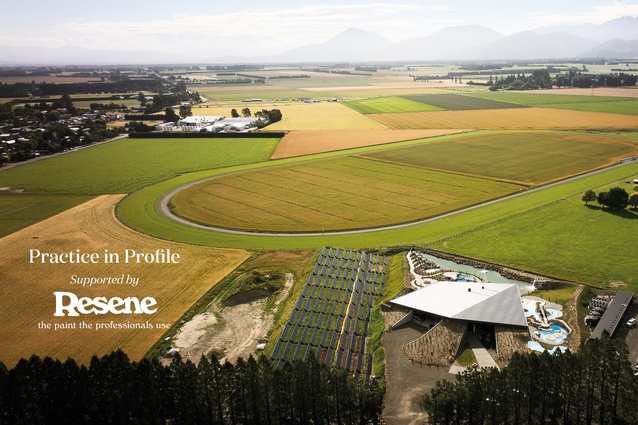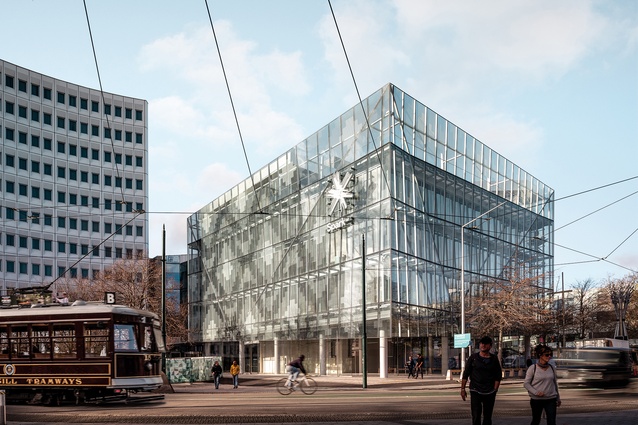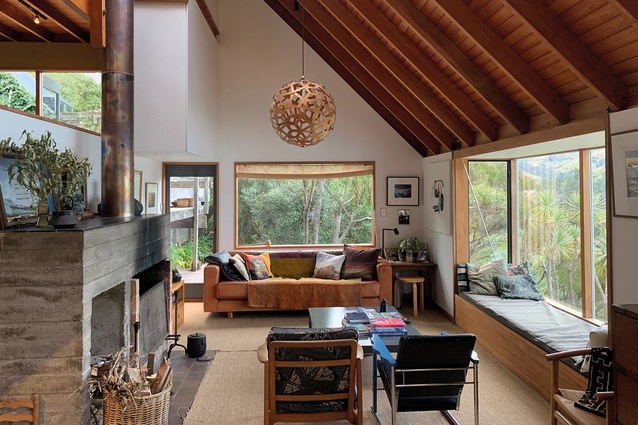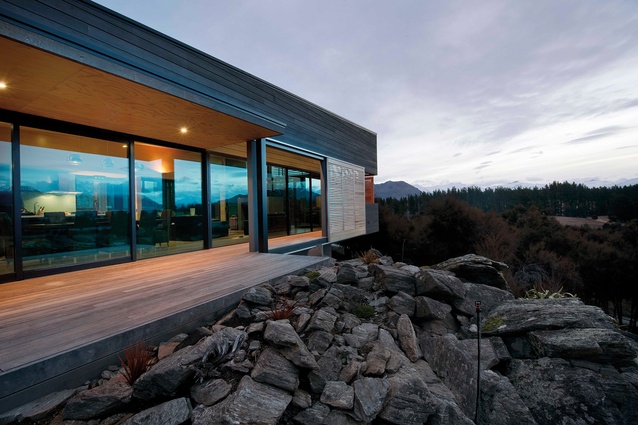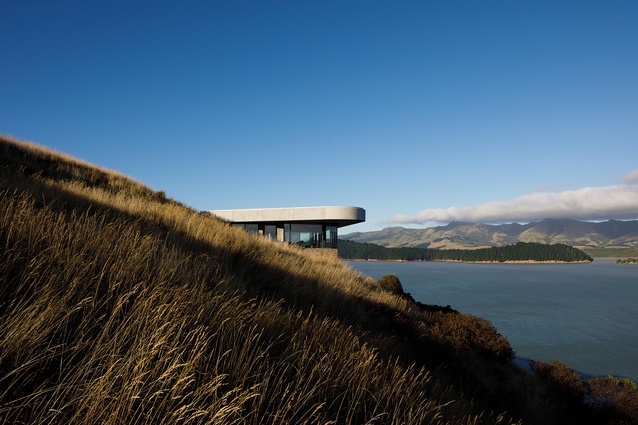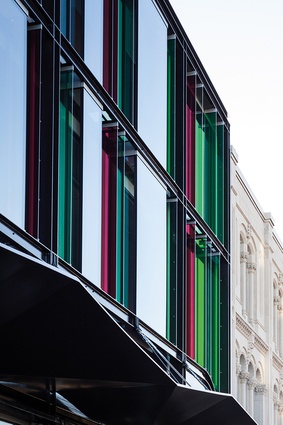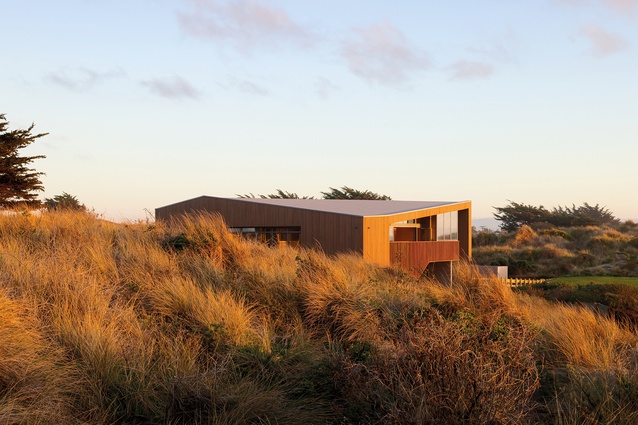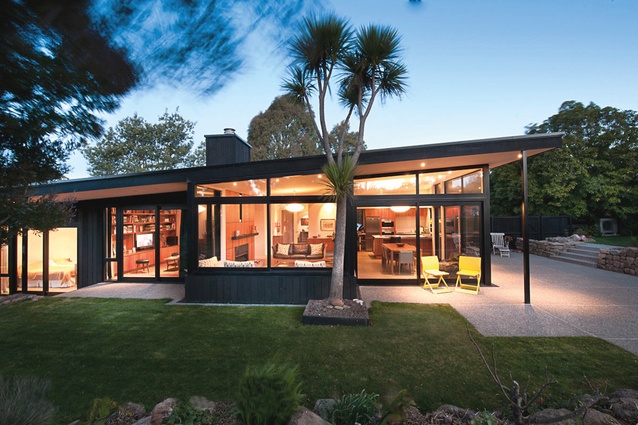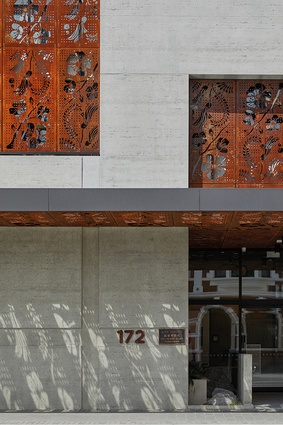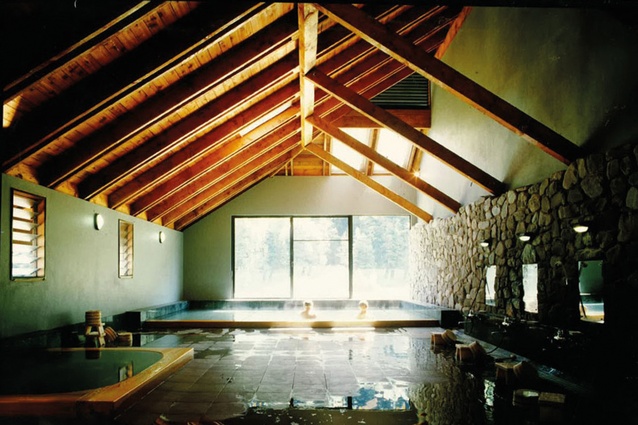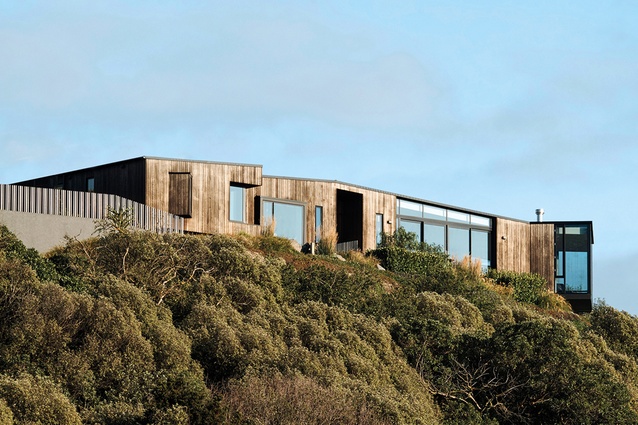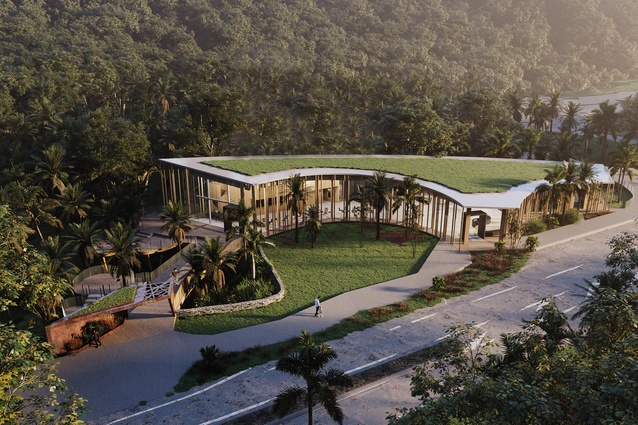Form follows narrative
Sheppard & Rout Architects has been part of Christchurch’s architectural scene for 40 years, now reaching an age where it has become an intergenerational practice. Here, directors Jasper van der Lingen, Tim Dagg, Steven Orr, Matt Gutsell and Joff Kennedy reflect on the practice’s enduring vision.
Sheppard & Rout still bears the names of its founders David Sheppard and Jonty Rout but now has a new generation of directors, Jasper van der Lingen and Tim Dagg, with a further generation emerging over the past two decades, associate directors Matt Gutsell, Jonathan Kennedy and Steven Orr.
With these transitions over the years to different individuals steering the ship, is there still a discernible consistency of approach? Is there a Sheppard & Rout philosophy and vision that has persisted over time? We certainly like to think so.
Looking back at what we have produced as a practice over the last 40 years is fascinating and instructive, bringing our underlying approach into sharper focus with the benefit of distance.
So where does inspiration come from as your pencil hovers over the intimidatingly blank piece of paper? It can come from anywhere, often unexpected and random: a place inhabited by your own memories, predilections and, of course, the specifics of the project. As David Mitchell suggested many years ago in his superb series The Elegant Shed, inspiration may come from the shape of chewing gum on the sole of your shoe. The point is taken; the spark that sets off a design, the big idea, the parti diagram of minimal lines that sums it all up, can come from anywhere.
For us, it seems to come, inherently, from the place in which we are designing. It involves deep consideration of a place in all its facets — context, environment, the ineffable particular atmosphere that every place has, the history and stories of the region, both fiction and nonfiction, the temporal dimension — the past and future or even some small cue taken from the area. It can become the key that lifts a building from being merely a utilitarian meeting of a functional requirement to something more. A deeper connection with place and people gifts a built environment with significance and meaning.
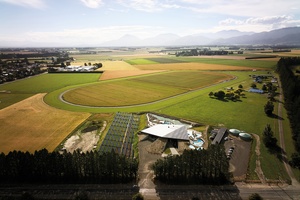
ŌPUKE THERMAL POOLS AND SPA
With the Ōpuke Thermal Pools and Spa, we conceived of the experience of the place as a journey. This journey takes us from the flat plains of Canterbury, a place the poet Brian Turner described as “where a leaf may be blown for a hundred miles and end up somewhere much the same” in his poem Crossing the Canterbury Plains, to the mystery and atmosphere of the mountains. You move from the flat car park and enter the building; the land looms up around you and masonry walls close in as if you were entering a gorge, and you finally emerge on the other side into the magical world of hot pools as if up amongst the tarns and natural springs in the mountains. It is attempting to evoke the essence and atmosphere of the Cantabrian experience and environment in which it is sited. By way of this re-presention, the place is given a significance and human meaning: a way of understanding and dealing with an, at times, complex and indifferent environment.
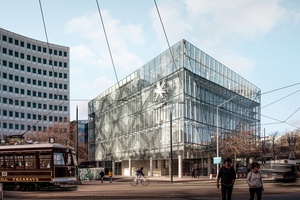
![]() SPARK HEADQUARTERS
SPARK HEADQUARTERS
Another recent example is the Spark Headquarters building in Cathedral Square, Christchurch. Here, we looked at both the context and the place, and an interpretation. of the business in which Spark is involved. We conceived of a digital communications company like Spark as a firm that, in a way, represents the world in a digital way. It takes analogue reality and transforms it into a pixilated, digital simulacrum that allows today’s contemporary world to function as it does. It is a way of understanding and reinterpreting reality so that we, as human beings, can deal with it. Considering these notions, we took the iconic building directly opposite, the Christchurch Cathedral, and pixilated its slate roof pattern, transferring it onto the outside face of the double-skin glazed façade. It now appears as a ghostly image floating in space like a virtual, digital twin of the older, heavy reality right next door. Once again, a building is telling stories that evoke what it is about and where it is, giving it meaning and, hopefully, poetry beyond its more prosaic requirement to house workers. Earlier projects also have this interest in the way narrative can drive design conceptual thinking.
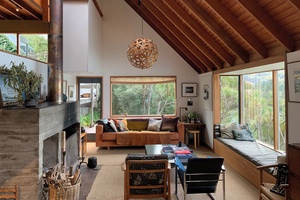
ROUT HOUSE
Jonty Rout, one of the two founding directors of Sheppard & Rout, designed a house for his family in Governors Bay in the 1980s. Situated on a steep slope covered in native vegetation and looking out to Lyttelton Harbour and the Pacific Ocean beyond, it was a dream site for an architect to create something truly special. The house itself is a tour de force of spatial richness and surprise with tectonic themes demonstrated throughout. As you descend the constructivist stairs, which tumble down the site, you catch glimpses everywhere of the land and sea all around reminding you and telling a story of the uniqueness of its setting. Expressing everywhere the way in which it is put together and what it is made of, it explains in its very fabric the human act of making and how we can poetically inhabit a beautiful piece of Aotearoa.
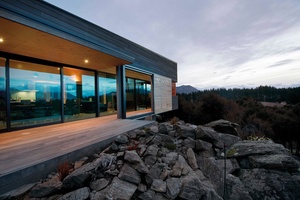
KĀNUKA RISE
The design of this new house took its major influence from its site on the northern slopes of Little Mount Iron, near Wānaka. The original hillside was covered in kānuka bush, which was to remain, and resource consent conditions stated it could be removed only where the immediate building platform was to be located. Therefore, a rock outcrop amongst the kānuka was selected and the house stepped down the slope to keep close to the land. Respecting this powerful, elemental Ōtago environment meant we kept the house lightweight, clad in timber, bleached to blend in with the tones of the surrounding kānuka. Sliding timber screens sheltering the outdoor verandah also help dematerialise the exterior, providing a layered effect with dappled light through the screens, suggesting light filtering through the kānuka itself. By representing the atmosphere of the place in built form, it becomes a human-made interpretation of it, reflecting on its environment and enabling an even-deeper appreciation of the world in which it sits.
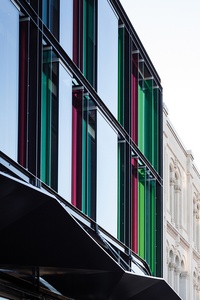
STRANGES LANE
The first permanent new build in the central city red zone after the Christchurch quakes, Stranges was a building that found itself in the unenviable position of leading the rebuild. This is a prominent, triangular central-city site and the question inevitably was, “how do we rebuild after the devastation that befell Christchurch?” The clear expression of strength and structure was considered to be important to reassure people that multi-storey buildings could be safe and could shelter them from the vicissitudes of an indifferent reality brought into stark relief with the earthquakes. A half-metre-thick, concrete egg-shaped core powerfully anchors the build and is displayed, where possible, poking prominently into the public laneway. The laneway provides space between existing and new, expressing the limited remaining building fabric left behind after the earthquakes. The exterior displays the perimeter steel structure with the glass façade stepping in and out with coloured fins between. This façade speaks not just of showing strength but also of past heritage buildings up and down Lichfield Street, now virtually all destroyed. The old, recessed windows, string lines, cornices and pilasters are all hinted at in the new building like a ghostly after-image of what was there before.
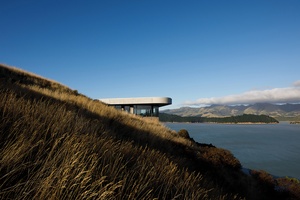
BLACK ROCK HOUSE
Set on a precipitous slope steeply descending into Lyttelton Harbour, the house at Black Rock is quite literally embedded into its place. It peers out bunker-like from the hillside as if the land has been peeled up to form a sheltered area under it that reveals the bedrock of the Black Rock headland beneath. A lower wall is formed from the stone excavated from the site itself and now revealed. The curved shape of the roof is an abstract representation of the headland itself, a fractal telescoping of where it is. The house, then, is fully of its place, presenting in constructed form the unique qualities and atmosphere of where it is. It is an architecture that allows its inhabitants to feel like they belong and, somehow, helps them make sense of and feel part of the dramatic environment all around.
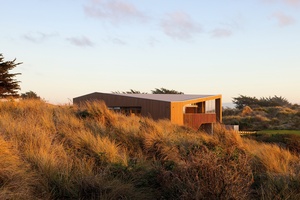
SOUTH BRIGHTON SURF LIFE SAVING CLUB
The concept for the recent rebuild of the South Brighton Surf Life Saving Club is again born from a considered response to the unique and precious natural environment which it inhabits. Located in the coastal dunescape, the building is set back from the beach and retained from the sand dunes. This enclosure provided by the ground-level retaining benefits the shelter of the lower level from the elements and allows the mass of the building to be reduced from the beach perspective. The building recesses into the site and is intended to be part of the sand-dune context, in both its angular organic form and its materiality. Conceived to be like driftwood, the building has a sculpted form wrapped in a timber-clad skin, protecting openings to the interior.
The singular form and material palette respond to the harsh environment with salt-laden easterly winds; it is finished in soft, natural tones to integrate with the sand dunes and grasses on either side of the site. The eroded form provides various recesses and openings where club and community users can shelter, dependent on prevailing environmental conditions. These recesses provide visual connection from the public realm and connections from the interior to the immediate sand-dune landscape, the distant Port Hills, the rugged sweep of Pegasus Bay and the Main Divide beyond. The building imbues a strong sense of place through its connection to the site and, as such, has evolved beyond a functional surf club, to a key focus within a somewhatdisregarded post-earthquake community.
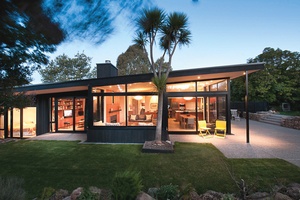
KENNEDYS BUSH HOUSE
Kennedys Bush on the edge of the city offers a degree of rural seclusion and a range of land sizes from one hectare upwards. The clients found one with some remnants of farm vegetation, fencing and a small vintage barn. In this setting, we went about achieving a home of modest size and enhancing the rural character and features of the land. The resulting house has a single storey, clad in dark cedar; it is located along the southern boundary of the site in order to maximise theoutlook to the north over the rest of the land, which has been left as undisturbed as possible and is grazed on occasion by sheep. Additional planting screens neighbouring homes from view and frames longer vistas out over the nearby rural environment.
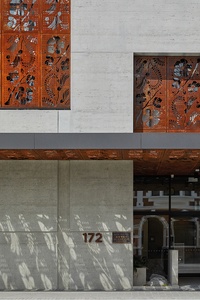
TOKYO EMBASSY AND JAPANESE CONSULATE
One of the key projects that set Sheppard & Rout up in the 1980s was the New Zealand Embassy in Tokyo. It was a job for which David Sheppard spent a lot of time in Japan overseeing its design and construction. A concrete building with simple square openings, it merged the spirit of Japanese architecture, with its emphasis on simplicity, considered and refined details, and materiality, epitomised by Tadao Ando, with the legacy of concrete construction so evident in the Christchurch Modern movement of the 1960s and ’70s.
Forty years on and we have revisited this as the architects for the Japan Consulate in Christchurch, New Zealand. A reciprocity has occurred with an intertwining of cultures, once again expressed in this more-recent building. Like the embassy in Tokyo, it is an orthogonal concrete building with simple rectangular openings and emphasis on simple but rich materiality. This time, though, the openings, for security reasons, are filled with metal screens. These screens are the work of local artist Morgan Mathews-Hale, facilitated by Matapopore, expressing the intertwining of a kōwhai flower with cherry blossom. The entry porch is also a dialogue between cultures with a Japanese-style garden using the gravel and river boulders of the Waimakariri River that form the shingle substrate of the whole Canterbury Plains.
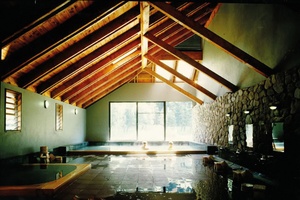
MARUIA HOT SRINGS
A project from the 1980s by Jonty Rout and David Sheppard was the Maruia Hot Springs, set in the mountains by the Lewis Pass. A Japanese-themed hot-pool experience, driven by the owners at the time, it also strongly told the story of South Island mountain huts, natural hot pools found up amongst the tumbling streams and the untouched dark native vegetation. The unpretentious, simple mono-pitch and gabled, board-and-batten, darkstained forms, placed in an informal way amongst the boulders of the Maruia River, tell of the ways in which we inhabit this part of the world in Aotearoa. The magnificent environment of the South Island high country has small mountain huts scattered throughout. The early ones are often simple, small timber-framed shelters not competing with the sublime immensity all around but evoking more the mythology described by John Mulgan in his book Man Alone, not dominating nature but living simply: a human being alone in the world. Man Alone has been described as one of the foundation stones of New Zealand literature. Maruia tries to capture this atmosphere where we are dwarfed as individuals by a world that is bigger, and more mysterious, majestic and fascinating than we are, while being quite indifferent to our presence.
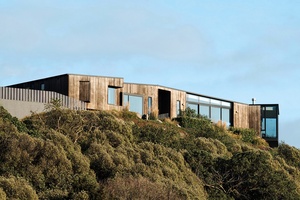
MONCKS SPUR HOUSE
This home occupies a distinctive site, poised on the edge of the lower end of Moncks Spur. It offers expansive views of the Christchurch Estuary and the mouth of the Avon River where it enters the sea and Pegasus Bay. To the east and south, it enjoys extensive vistas of the dramatic Port Hills behind Clifton Hill and Sumner. The house extends informally over the site, mimicking the existing contours and capturing the range of views out over the natural features surrounding it. When viewed from below, the form appears to be on a single level, hugging the site and, only when viewed from its immediate elevation, does the lower level reveal itself.
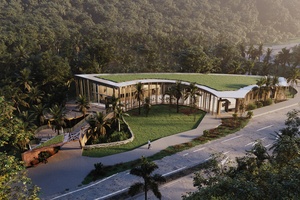
DOLOMITE POINT VISITOR CENTRE
The Department of Conservation Visitor Centre in Punakāiki, West Coast, currently under construction, is another attempt to imbue a building with meaning by telling stories in its very fabric: stories about the place where it is and the time it was built. The location is a precious and sensitive natural environment with a unique set of challenges. It sits in a Karst landscape amongst dolines and tomos: sinkholes that can be 6m deep. The natural vegetation is dominated by nīkau, since Punākaiki is its most significant natural habitat; the unique wildlife includes native bats, lizards, kiwi and endangered Westland petrel and this means that anything we bring here needs to be placed with immense care and sensitivity to avoid disturbing the ecosystem as much as possible. So, what was the big idea and narrative that drove the design in this case?
The idea was to dissolve the building as much as possible. Like camouflage, it will blend into the surroundings and reflect them, becoming a human-made representation of its environment. It is surrounded by a layer of cylindrical timber columns, placed in a random pattern that curves, bends and weaves amongst the existing nīkau. These timber columns mimic the straight, cylindrical trunks of the nīkau all around, blurring the boundary between the constructed and the natural. It will have a green roof, essentially replicating the lost ground-level vegetation at a higher level, providing a great habitat for the local flora and fauna. It is also designed to be highly sustainable, responding to the challenges and critical issues of our day. An almost-full timber structure, including a raised timber floor, is sourced from locally FSC-certified (Forest Stewardship Council) sources helping support the local economy as well as sequestering carbon. It also reflects the cultural narrative gifted by the local iwi Ngāti Waewae and has artwork by Fayne Robinson embedded into the design and fabric. It is, therefore, in its own way, another attempt to give meaning to what we do, lifting a building up to something more than just its function.
Form follows narrative is maybe a more accurate description of what we do, compared with the ubiquitous ‘form follows function’ of the 20th century. For, you can argue, it is the stories that have given our land Aotearoa its meaning and imbued it with significance and richness. It is a whakapapa that connects us in a deep way with the land, the sky and architecture, which stretches back to the first inhabitants who reached these shores. We attempt to make architecture similar to poetry, evoking deep atmospheres of a place and time, representing and interpreting, giving human meaning to the mere fabric of reality.
Sheppard & Rout Architects is a design-led practice based in Christchurch, with a 24-person-strong team, which delivers a diverse range of projects throughout New Zealand. The practice treats each of its projects individually, aiming for purposeful design responses that are relevant to the project’s context.

